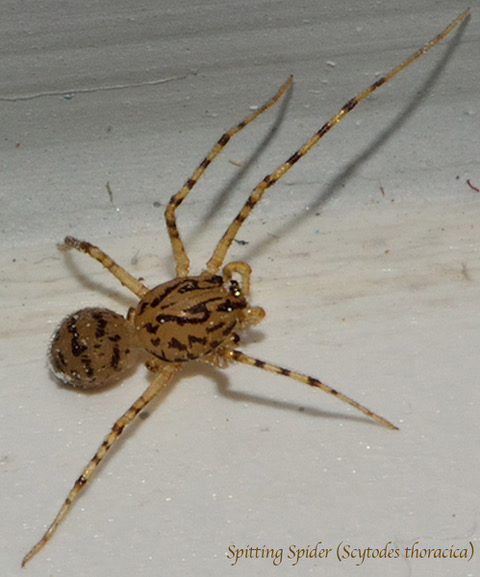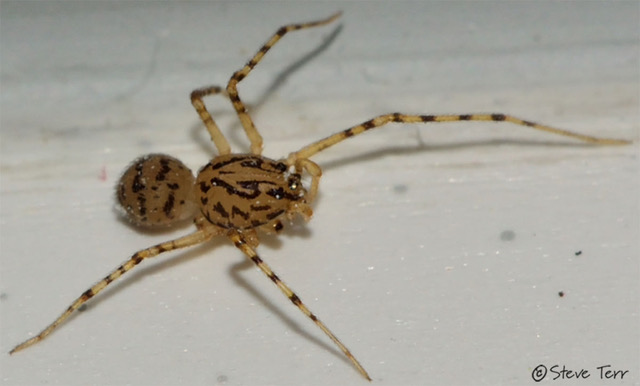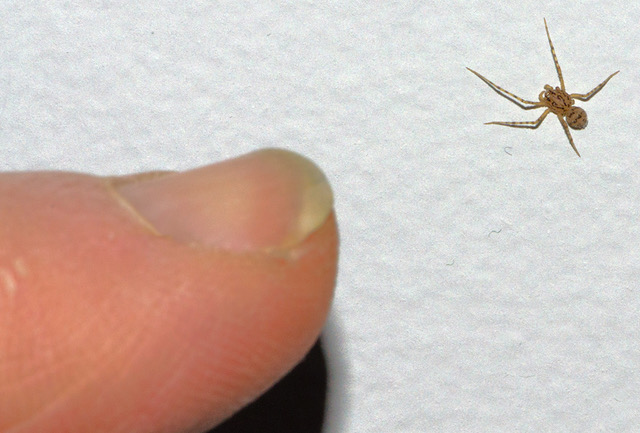The Speck on the Wall

By Steve Terr
"If you wish to live and thrive, let the spider run alive"
After spending a good part of the afternoon gardening, I enter the small bathroom on the first floor of my house to wash up. A miniscule speck of something appears on the far wall. Pavlov’s dogs were conditioned to salivate at the sound of a bell. My brain, similarly conditioned by multiple past experiences, salivates at the sight of specks on a wall. I spin around. Run for my camera, grab it and run back. All along a wild hope within my brain, a flashing neon sign; “I hope it isn’t gone…I hope it isn’t gone…” I re-enter the bathroom and scan the wall. It isn’t gone! The speck is still there!
Carefully, I approach the wall. With each step taken the anonymous particle grows larger, changes shape and lightens in color. Finally this dot magically morphs into a tiny spider. At that point, if asked to define what happiness is, I would respond that, “Happiness is the discovery of a tiny spider on a gray bathroom wall.” It slowly begins to crawl across the wall. I begin taking pictures. The chase is on! All of my attention is taken up with the intent of capturing an image of this mysterious arachnid before it escapes into nearby crevice or crack.
But, why do I want to do this?
Why don’t I just exterminate it? Or, more humanely, why don’t I capture it in a plastic container and free it to the outside world? Why aren’t I overwhelmed by arachnophobia? The answer is that I am overwhelmed with arachnophilia. I find spiders entertaining and damned interesting. I am attracted by this mysterious stranger’s strangeness. It is one of a dazzling multitude of life forms with which we coexist, within the confines of our houses. Anyone can kill a spider. Likewise, anyone can learn about them. I choose to learn.
Currently, about 4,000 identified species of spider inhabit North America. So, there is a good possibility that any chance encounter with an individual spider will not be on a first or last name basis. And so it is with the anonymous spider I am now surveying. After observing it and taking a good number of photographs I, somewhat reluctantly, leave the bathroom and the spider on the wall.
I upload the images on my computer. I then edit, format and submit the best shots to bugguide.net. (This is a useful web site for identifying insects, spiders and their kin) After a while, an email arrives notifying me to log on to their site. I do so and am elated to discover that the spider is no longer an anonymous speck. It was dubbed, in 1802 by Pierre André Latreille, a French zoologist, with the binomial appellation: Scytodes thoracica (“sky-TOH-deez tho-RASS-ih-kuh”). I am now on a first and last name basis.
As you will no doubt agree, Scytodes thoracica is a rather dapper spider. It is overall of an appealing tannish hue. The entire length of each of its gracefully tapering legs is decorated with a rhythmic succession of widely spaced, dark brown stripes. Two large calligraphic shapes, resembling the scrolled openings found on violins, adorn the top of the largest segment of its body which is bordered with an artful succession of dashes and scribbles. This first segment is termed the “cephalothorax.” This is attached to the abdomen via a short, wasp-waist called the “pedicle,” A delightful variation of the calligraphic motif found on the cephalothorax, decorates the abdomen. All in all this creature presents a charmingly barbaric and artistic appearance, as does any wildly, but tastefully, attired animal, be it inhuman or human.
Scytodes thoracica is a well dispersed species, found in North America, Europe, Asia, Australia, Polynesia and Bay Shore, NY. In the wild they are found in temperate forests, under leaf litter and rocks. In places like Long Island where it tends to get a bit cool in winter, they have developed synanthropic proclivities, i.e., they like to keep warm, snuggle up and feel at home in human habitations. It is not uncommon to find them eking out a living in cellars, cabinet corners and small bathrooms, etc.
At a very young age I memorized the following maxim, which poses the rhetorical question, “How can you expect to rate if you expectorate?” But, like many adages, there are limits to its sagacity and application. In the case of the upbringing of Scytodes, this maxim’s wisdom is maxed out and turned on its head. If and when any Scytodes parent was to admonish a misbehaving spiderling it would be heard to say, “How do you expect to rate if you don’t expectorate.” The genus Scytodes is made up of, approximately, 225 species of spiders, all of which spit for a living.
This spider is not usually very active during the day but, when the sun sets, nighttime is the right time for Scytodes to go hunting for supper or a mate. We will cover both appetites in the paragraphs below.
When we humans go hunting for our suppers, we either pick up a gun or we go to a large well-lit supermarket or swanky restaurant. Scytodes chooses to circumambulate the darkness on its six rear legs, while raising the front two legs and waving them about. The front two legs are equipped with small specialized bristles called “setae.” These setae can sense vibrations and odors and help locate prey that might be out there in the gloom. Once it detects its victim, it lowers the forelegs and patiently taps its way forward. All the while attempting to discern the location of the unsuspecting meal waiting in the shadows.
Once within range, the chelicerae or fang-tipped mouthparts are raised and the body is compressed. Within 1/700 of a second, a zig-zag spray of sticky, envenomed silk is expectorated through the pair of oscillating fangs. The victim is netted and immobilized. Scytodes rushes forward. Directly bites the immobilized victim injecting more venom. Simultaneously, using its second pair of legs to wrap even more silk around and securely ensnare the prey. Some time passes while the hunter waits for the silk to dry and the injected venom to liquefy the internal organs of the now moribund prey. When all is ready, Scytodes bellies up to the bar and drinks down its diner. However, this arachnid must forever be on the alert. In nature, it is not uncommon to find that the hunter becomes the hunted. And so it is with Scytodes. The predatory inclinations of centipedes, toads, bats, cats, shrews, even other spiders, etc., can, in an instant, transform Scytodes from being a diner to being a dinner.
This then adds another twist to the plot and transforms the ability to eject venom soaked silk from an offensive to a defensive weapon. Although how effective this is actually, is open to question. As my wife and many others have noticed, much to their discomfort and dismay, spiders typical come equipped with eight legs. Notice that the individual photographed on my bathroom wall has only five of the eight still attached. But let us not end on this disturbing note. I have yet to discuss the second of the two appetites, as promised above.
Both sexes lead solitary lives. There are no dating web-sites in Scytodes life. Although they have six eyes, their sight is poor and they typically dwell in darkness. So their meeting is a randomized blind date, arranged by fate and volatile chemicals called “pheromones.” When feeling amorous, spitting spiders release specific pheromones into the surrounding environment. Remember those waving forelegs bristling with sensory setae? While meandering about in a warm, dank, romantically moonlit basement and nonchalantly waving his legs in the air a male may get wind of this powerful perfumed love poem. As he follows this scent and approaches his prospective mate he must adhere to spider etiquette and approach her from the front. He must be sure to unambiguously present himself as a lover. If not, he runs the risk of being sensed as a predator or prey. If all goes well, the male spins a single thread of silk. He passes this thread over his genital area and deposits sperm upon it. The receptive female raises her body exposing her genital area. He then removes the sperm from the silk and, via small organs found at the front of his body, places his gift therein. They immediately separate to continue their solitary lives. She stores the sperm within her body and fertilizes her eggs when ready.
Her eggs are laid in a loosely woven cocoon of silk and carried in her mouth or under her body until they hatch. This is Scytodes expression of maternal love, although on occasion they have been known to eat their young. Once they hatch she watches over them until their first molt and then…they are on their own.
After I get the results from bugguide.net, I return to my bathroom wall. Alas, Scytodes is gone. But, I am richer for the experience and they are excellent pest controllers.
As of the writing of this article, I have never seen my co-habitant again…but I am hopeful and my camera is always ready.







